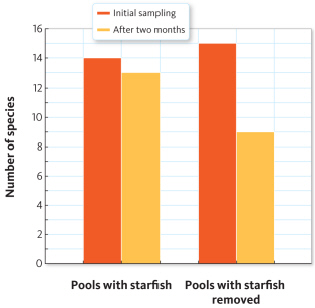Robert Paine was the first biologist to use the term keystone species in the 1960s. He was studying food webs in the rocky, intertidal pools in the Pacific Northwest. At one of his study sites, the dominant organisms in the tidal pools were mussels, barnacles, whelks, and a species of starfish known as Pisaster ochraceus . To examine the relationship between these species, Paine set up an experiment. In one area, he removed all the starfish from the tidal pools, and in an adjacent area, he left the tidal pools as he found them. Prior to removing the starfish, he sampled all the organisms in each pool. After two months, he repeated this sampling. A summary of his results is illustrated in the graph below.
As mussels and barnacles feed, how much of the energy that they take in from food is available to the whelks that eat them?
A) 10 percent
B) 90 percent
C) 1000 calories
D) 10,000 calories
Correct Answer:
Verified
Q31: Robert Paine was the first biologist to
Q32: Spiders are predators that will eat just
Q33: A beetle that feeds on the leaves
Q34: A beetle that feeds on the leaves
Q35: Some species of bean bug, which are
Q36: A beetle that feeds on the leaves
Q37: Which of the following forms of communication
Q38: Certain types of mites can often be
Q39: Robert Paine was the first biologist to
Q40: A beetle that feeds on the leaves
Unlock this Answer For Free Now!
View this answer and more for free by performing one of the following actions

Scan the QR code to install the App and get 2 free unlocks

Unlock quizzes for free by uploading documents